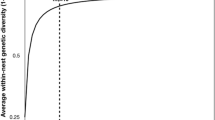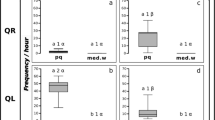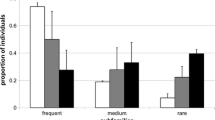Abstract
We investigated the different levels of selection that may influence the queen replacement process in honey bees by monitoring queen–queen and worker–queen interactions in queenless observation colonies containing populations of paint-marked workers that were either related or not related to introduced virgin queens experimentally reared to be of low- and high-quality, as estimated by differences in size and potential reproductive capacities. The high-quality queens were more likely to survive and become the new laying queen of their colonies. Queen survival was positively associated with both queen fighting ability and worker–queen interactions. Surviving queens were more aggressive and had greater fighting success. However, surviving queens were not bigger than killed queens nor were they the first queens to emerge, suggesting that queen size and early emergence alone are not the determining factors of queen fighting ability. The worker–queen interaction that was most strongly associated with the outcome of queen replacement was the vibration signal, which is a communication signal that workers perform on virgin queens. Surviving queens were vibrated at rates 3–4 times those experienced by killed queens and a queen’s vibration rate was positively correlated with her fighting ability and the number of rivals killed. Workers showed no consistent preferences for related vs. unrelated queens and the proportion of interactions received from related workers was not associated with any aspect of queen fighting ability and success monitored. Our results suggests that caste interactions during queen replacement have been shaped by both selection acting at the level of the individual queen (which favors higher quality queens with greater fighting ability) and selection acting at the level of the colony (which favors workers directing vibration signals towards queens with greater fighting potential), ultimately resulting in a higher quality queen becoming the new laying queen of the colony. Selection acting at the level of the individual worker through kin selection, which would favor preferential treatment of related queens, did not consistently influence caste interactions or the outcome of the replacement process. Thus, the outcome of queen replacement in honey bees may be determined primarily by a combination of a queen’s inherent fighting ability coupled with the rate at which she receives some interactions (particularly vibration signals) from workers.









Similar content being viewed by others
References
Amor F, Ortega P, Jowers MJ, Cerdá X, Billen J, Lenoir A, Boulay RR (2011) The evolution of worker–queen polymorphism in Cataglyphis ants: interplay between individual- and colony-level selections. Behav Ecol Sociobiol 65:1473–1482
Babis M, Holman L, Fenske R, Thomas ML, Baer B (2014) Cuticular lipids correlate with age and insemination status in queen honeybees. Insect Soc 61:337–345
Bernasconi G, Ratnieks FLW, Rand E (2000) Effect of “spraying” by fighting honey bee queens (Apis mellifera L.) on the temporal structure of fights. Insect Soc 47:21–26
Châline N, Martin SJ, Ratnieks FLW (2005) Absence of nepotism toward imprisoned young queens during swarming in the honey bee. Behav Ecol 16:403–409
DeGrandi-Hoffman G, Watkins JC, Collins AM, Loper GM, Martin JH, Arias MC, Sheppard WS (1998) Queen developmental time as a factor in the Africanization of European honey bee (Hymenoptera: Apidae) populations. Ann Entomol Soc Am 91: 52–58
Dietemann V, Zheng H-Q, Hepburn C, Hepburn HR, Jin S-H, Crewe RM, Radloff SE, Hu F-L, Pirk CWW (2008) Self assessment in insects: honeybee queens know their own strength. PloS One 3(1):e1412. doi:10.1371/journal.pone.0001412
Gilley DC (2001) The behavior of honey bees (Apis mellifera ligustica) during queen duels. Ethology 107:601–622
Gilley DC, Tarpy DR (2005) Three mechanisms of queen elimination in swarming honey bee colonies. Apidologie 36:461–474
Gilley DC, Tarpy DR, Land BB (2003) Effect of queen quality on interactions between workers and dueling queens in honey bee (Apis mellifera L.) colonies. Behav Ecol Sociobiol 55:190–196
Goins A, Schneider SS (2013) Drone “quality” and caste interactions in the honey bee, Apis mellifera L. Insect Soc 60:453–461
Hatch S, Tarpy DR, Fletcher DJC (1999) Worker regulation of emergency queen rearing in honey bee colonies and the resultant variation in queen quality. Insect Soc 46:372–377
Katzav-Gozansky T, Soroker V, Ibarra F, Francke W, Hefetz A (2001) Dufour’s gland secretion of the queen honey bee (Apis mellifera): an egg descriminator pheromone or a queen signal? Behav Ecol Sociobiol 51:76–86
Laidlaw HH Jr (1979) Contemporary queen rearing. Dandant & Sons, Hamilton
Lattorff HMG, Moritz RFA (2016) Context dependent bias in honeybee queen selection: swarm versus emergency queens. Behav Ecol Sociobiol 70:1411–1417
Loope KJ (2015) Queen killing is linked to high worker–worker relatedness in a social wasp. Current Biol 25:2976–2979
Matilla HR, Seeley TD (2007) Genetic diversity in honey bee colonies enhances productivity and fitness. Science 317:362–364
Oldroyd BP, Fewell JH (2007) Genetic diversity promotes homeostasis in insect colonies. Trends Ecol Evol 22:408–413
Rangel J, Keller JJ, Tarpy DR (2013) The effects of honey bee (Apis mellifera L.) queen reproductive potential on colony growth. Insect Soc 60:65–73
Rangel J, Böröczky K, Shal C, Tarpy DR (2016) Honey bee (Apis mellifera) queen reproductive potential affects queen mandibular gland pheromone composition and worker retinue response. PLoS One 11(6):e0156027 doi:10.1371/journal.pone.0156027
Ratnieks FLW, Foster KR, Wenseleers T (2006) Conflict resolution in insect societies. Annu Rev Entomol 51:581–608
Robinson GE (1984) Worker and queen honey bee behavior during foreign queen introduction. Insect Soc 31:254–263
Sanford MT (2001) Queen problems. Apis Newsletter (April). University of Florida, Gainesville
Schneider SS (2015) The honey bee colony: life history. In: Graham JM (ed) The hive and the honey bee. Dadant & Sons, Hamilton, pp 73–110
Schneider SS, DeGrandi-Hoffman G (2002) The influence of worker behavior and paternity on the development and emergence of honey bee queens. Insect Soc 49:306–314
Schneider SS, DeGrandi-Hoffman G (2003) The influence of paternity on virgin queen success in hybrid colonies of European and African honey bees, Apis mellifera. Anim Behav 65:883–892
Schneider SS, DeGrandi-Hoffman G (2008) Queen replacement in African and European honey bee colonies with and without afterswarms. Insect Soc 55:79–85
Schneider SS, Lewis LA (2004) The vibration signal, modulatory communication and the organization of labor in honey bees, Apis mellifera. Apidologie 35:117–131
Schneider SS, Painter-Kurt S, Degrandi-Hoffman G (2001) The role of the vibration signal during queen competition in colonies of the honeybee, Apis mellifera. Anim Behav 61:1173–1180
Sokal RR, Rohlf FJ (1995) Biometry. Freeman, New York
Tarpy DR (2003) Genetic diveristy within honey bee colonies prevents severe infections and promotes colony growth. Proc R Soc Lond B 270:99–103
Tarpy DR, Fletcher DJC (1998) Effects of relatedness on queen competition within honey bee colonies. Anim Behav 55:537–543
Tarpy DR, Fletcher DJC (2003) “Spraying” behavior during queen competition in honey bees. J Insect Behav 16:425–437
Tarpy DR, Gilley DC (2004) Group decision making during queen production in colonies of highly eusocial bees. Apidologie 35:207–216
Tarpy DR, Mayer MK (2009) The effects of size and reproductive quality on the outcomes of duels between honey bee queens (Apis mellifera L.). Ethol Ecol Evol 21:147–153
Tarpy DR, Gilley DC, Seeley TD (2004) Levels of selection in a social insect: a review of conflict and cooperation during honey bee queen replacement. Behav Ecol Sociobiol 55:513–523
Tarpy DR, Hatch S, Fletcher DJC (2000) The influence of queen age and quality during queen replacement in honeybee colonies. Anim Behav 59:97–101
Tarpy DR, Keller JJ, Caren JR, Delaney DA (2011) Experimentally induced variation in the physical reproductive potential and mating success in honey bee queens. Insect Soc 58:569–574
Tarpy DR, Simone-Fenstrom M, Linksvayer TA (2016) Honey bee colonies regulate queen reproductive traits by controlling which queens survive to adulthood. Insect Soc 63:169–174
Vissher PK (1993) A theoretical analysis of individual interests and intracolony conflict during swarming of honey bee colonies. J theor Biol 165:191–212
Webster TC (1998) Queen problems—survey results. Bee Cult 126:40–41
Wenseleers T (2007) Nepotism absent in insect societies—or is it? Mol Ecol 16:3063–3065
Wilson EO, Hölldobler B (2005) Eusociality: origin and consequences. Science 102:13367–13371
Winston ML (1987) The biology of the honey bee. Harvard University Press, Cambridge
Wossler TC, Crewe RM (1999) Honeybee queen tergal gland secretion affects ovarian development in caged workers. Apidologie 30:311–320
Woyke J (1971) Correlations between the age at which honeybee brood was grafted, characteristics of the resultant queens, and results of insemination. J Apic Res 10:45–55
Acknowledgements
We thank J Benfield, Z Chamberlain, C Clark, S Devaney, S Diep, E Headley, A Hudson, L Keller, S Kent, J Lawson, J Mavellia, C Onia, D Pham, M Radkin, J Richards, S Rodman, B Sierra, D Tran, and K Szewczky for their many hours of help with marking bees and monitoring the observation colonies. Funding was provided by the National Science Foundation Award No. 1262472.
Author information
Authors and Affiliations
Corresponding author
Rights and permissions
About this article
Cite this article
Long, K., Cao, T.T., Keller, J.J. et al. Levels of selection shaping caste interactions during queen replacement in the honey bee, Apis mellifera . Insect. Soc. 64, 227–240 (2017). https://doi.org/10.1007/s00040-016-0537-4
Received:
Revised:
Accepted:
Published:
Issue Date:
DOI: https://doi.org/10.1007/s00040-016-0537-4




